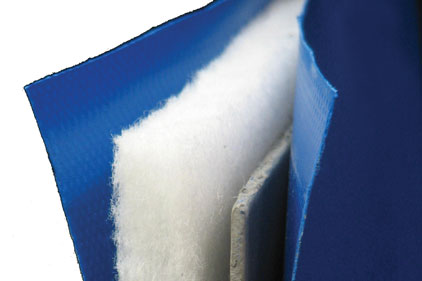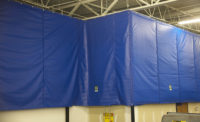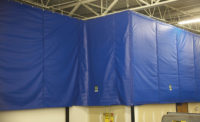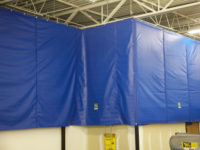These noise levels are unfortunately pretty common in facilities with assembly and machine tool operation; process equipment such as pumps, compressors and blowers; material handling equipment like conveyors and fork trucks; and the regular use of power hand tools like saws, grinders and drills. OSHA estimates more than 30 million workers in industrial settings are exposed to hazardous levels of noise each year in the U.S.
In addition to long-term damage, OSHA warns that excessive noise can cause physical and psychological stress, reduce productivity, interfere with communication and concentration, and contribute to workplace accidents and injuries.
Common noise control methods
Due to the dangers of extreme sound levels, OSHA requires employers to limit employee noise exposure to 90 dB or less on an 8 hour time-weighted average basis.
There are many options when it comes to noise control in an industrial environment. Redesigning or replacing loud equipment with new, quieter models is one option. But it’s not always possible due to the cost or availability of quieter equipment. Some noisy machines can be modified with isolation pads or vibration dampeners to reduce or vanquish excessive sound. Encasing machines in sound-absorbing enclosures or materials is another option.
Another possibility is to implement noise reduction barriers. Typically these barriers are rigid, insulated walls or partitions strategically placed to block the path of transmitted sound waves, and absorb and scatter them, reducing the total sound power level (dB) that actually reaches the affected employees.
Finally, personal hearing protection for individual employees, such as earplugs or ear muffs, can defend against excessive noise levels. They are effective noise protection when worn (and properly fitted), but they can also hinder audible communication between employees. In facilities where hearing protection is required, OSHA mandates regular hearing testing of affected employees.
Controlling facility noise with a new approach
Another option similar to rigid, permanent walls is sound-attenuating curtain walls. Acoustic curtain walls have Sound Transmission Coefficients ranging up to 30+, making them an effective alternative.
Acoustic curtain walls normally consist of two layers of a woven, coated fabric surrounding one or more layers of various insulating materials. These materials might include fiber batting (polymer or glass), open cell foam, or densified “loaded” vinyl or other flexible polymer sheet material.
Each component plays an important role in reducing sound levels encroaching on the curtain surface. The mass loaded vinyl sheet in a sound curtain is more effective in reducing lower frequency noise than the other components (low frequency sound is best absorbed or deflected with high density solid materials). Fiber batting is effective in reducing sound at mid to higher range frequencies. Open cell foam (like a viscoelastic) will also offer noise reduction over a range of frequencies, but care must be taken to make sure the foam used is effectively treated for flame retardance.
The interior core of a typical sound curtain will consist of a layer of sound-dampening, loaded vinyl and a layer of antimicrobial polyester batting as an additional sound buffer that also serves to fill out and maintain the body of the panel. This core is captured between two outer layers of 18-oz. flame retardant vinyl, available in a number of colors for aesthetics.
Typically, the loaded vinyl side of the core is positioned facing the offending noise source, between the source and the desired ambient sound area. In a completed installation, the wall acts to trap the sound in a specific area and limit the migration of the sound to the ambient employee areas.
Flexible acoustic curtain walls offer a relatively new approach to providing employee safety and comfort when it comes to noise levels in a commercial or industrial facility. These fabric curtains can be effectively used for noise source insulation, as well as for noise path insulation. Noisy machines can be wrapped in flexible sound curtains, like a “blanket.” They can also be attached to a close quarters support frame around the equipment.
Larger sound enclosures can be formed using these curtains, including complete rooms or separating walls. In a typical application of this sort, a metal mounting angle is installed across or along a run of the roof supporting bar joists (welded, clamped or bolted), and the insulated curtain is simply screwed to this angle along its top edge using self-drilling screws. The curtains are normally made of 5-foot-wide panels and have vertical Velcro attachment hems to join multiple panels, creating a full width curtain.
Flexibility of curtain walls
In addition to their excellent noise reduction performance, flexible curtain walls as noise barriers offer other advantages, like their flexibility.
Curtains can be configured to fit virtually any interior space and require significantly less time to set up than to build permanent walls. Individual fabric panels of virtually any length are interconnected with Velcro to form each continuous wall.
Curtain walls also can be reconfigured easily to adapt to changing production demands and floor layouts. It’s easy to add to or enlarge an initial curtain wall installation. If source sound levels increase for any reason, it is simple to add a second layer of flexible sound curtain to an existing one, or even to augment an existing rigid wall (a fairly common application). Also, these fabric-covered walls can be easily cleaned with simple detergent and water.
Flexible sound curtains not only insulate against noise transmission, but can simultaneously be effective at providing thermal insulation, preventing condensate or frost buildup, and light blocking, if desired.



